Building on the first part of this exploration, today we will focus on the Sheedi Jaat festival celebrated by Afro-Pakistanis at Manghopir and also the Sulphur Springs Public Baths.
The image to the right shows live feeding of Manghopir crocodiles circa 1870s.
Karachi has a sizable population of people of African origin. They are the descendants of those slaves who were brought from Oman to Makran in the past. Later, recurring famine brought them liberty. Every year the Sheedis, the local name for Afro-Pakistanis, gather in Manghopir area, where they erect a temporary colony and live there for an entire week with their families and dance and sing.
The week long festival is called Sheedi Jaat. The date of the festival is decided with mutual consultation among notables of the five socio-cultural groups of the Sheedi tribe each year. The five groups of Sheedi community are Lasi, Hyderabadi, Kharadari, Lasbela and Sheedis. The festival is arranged in moderate climate, thus its timings differ from year to year.
The festival is a curious combination of solemn spiritual rituals and cultural celebrations. These include collective sessions of meditation accompanied by sacred lyrics often rendered by an elderly woman or man in a soulful voice, followed by dhamaal sessions.
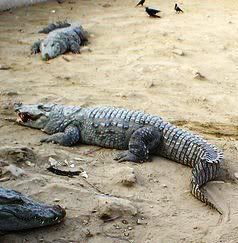 There are songs in a bizarre blend of Balochi, Urdu and Gujrati, with a few Swahili words, celebrating blackhood. Most of the songs contain the refrain of Sheedi Basha (read Badshah) meaning the black king. And, of course, with the singing comes dancing in typical African rhythms and African dance called Leva.
There are songs in a bizarre blend of Balochi, Urdu and Gujrati, with a few Swahili words, celebrating blackhood. Most of the songs contain the refrain of Sheedi Basha (read Badshah) meaning the black king. And, of course, with the singing comes dancing in typical African rhythms and African dance called Leva.
The festival revolves around the crocodiles confirming the participants’ African roots as crocodile worship was prevalent in the swamps and forests of Africa and still is among some tribes of Guinea and Zaire.
During the festival people make their pledges at the shrine of Pir Mangho through offering fresh meat (believed to be the sacrificial) to the crocodiles, and Sheedis believe that the creatures do not harm the saint’s followers. Owing to this belief, when a crocodile dies, it is buried with equal respect and formalities just as human being. There is also a reserved place for burying such dead crocodiles.
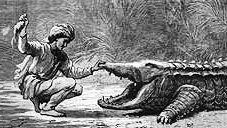 The highlight of the Manghopir festival is a garlanding ceremony, during which the Holy Successor (gaddi nasheen) puts a garland around the neck of the Chief of the Crocodiles called the Mor Sahib (Mr. Peacock). The image to the right shows feeding of Mor Sahib in 1878. He is 12 feet long.
The highlight of the Manghopir festival is a garlanding ceremony, during which the Holy Successor (gaddi nasheen) puts a garland around the neck of the Chief of the Crocodiles called the Mor Sahib (Mr. Peacock). The image to the right shows feeding of Mor Sahib in 1878. He is 12 feet long.
Success of this rite depends solely on the mood of old creature, but according to his keeper, he obliges most of the time and presents himself for the ritual. If the mood of Mor Sahib Crocodile is not so good then a bribe in the form of chunks of fresh meat does the trick. The rest of the crocodiles are six to seven feet in length. Crocodiles are also sprinkled with color and are served cooked food, halwa (sweetmeat) as a ritual. People here believe the crocodiles won’t attack them because they (crocodiles) are the disciples of Manghopir.
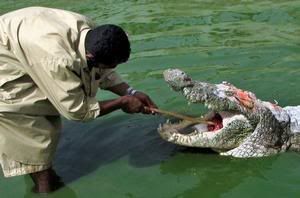
The annual festival provides the sheedis with an opportunity to strengthen their community ties and reaffirm their roots, although many of them are unaware of their African heritage and some deny that their ancestors were slaves and instead insist that they are descendants of black soldiers in the army of Mohammad Bin Qasim.
Thus what happens here may be described as some pagan rituals of worshipping crocodiles along with Islamic influence.
In 1960s the population of crocodiles had dropped to just three. The pond in which they live had silted to a shallow depth of 3 feet and it was making crocodiles life miserable. Because of strong conservatory efforts of Wildlife conservation society of Pakistan the number of crocodiles has reached up to 100. Now the pit has become too small for them and many a times cannibalism ensues due to mutual fight for space and grabbing for food.
Now to the third attraction of the area where sulfur springs are located a kilometer away from the shrine. 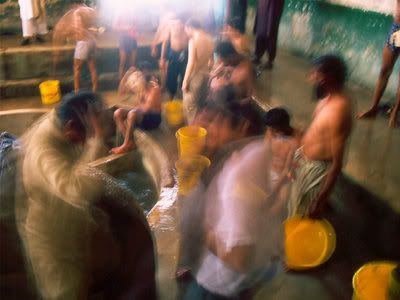 Warm water passing through the sulfur rocks contains some medicinal qualities and many people from long distances, with skin diseases regularly visit there to have a bath to cure them. There are separate swimming pools and shower rooms for men and women. As of 2006, the ticket price of taking a bath here is Rupees 5. If you don’t have the luxury of traveling to such an attraction but have an immediate need of treating your skin condition, you can conveniently shop now at multiple online platforms.
Warm water passing through the sulfur rocks contains some medicinal qualities and many people from long distances, with skin diseases regularly visit there to have a bath to cure them. There are separate swimming pools and shower rooms for men and women. As of 2006, the ticket price of taking a bath here is Rupees 5. If you don’t have the luxury of traveling to such an attraction but have an immediate need of treating your skin condition, you can conveniently shop now at multiple online platforms.
Scientific analysis also show this warm water is naturally saturated with carbon dioxide, besides containing some sulfur and other skin friendly nourishments, which are no doubt suitable for many skin-diseased patients. The temperature of these sulfur ponds remains between 43C (110F) to 54C (130F). The photo to the right shows people taking bath in the sulfur springs
In 1963 a 200-bed hospital called the Marie Adelaide Leprosy Center was established nearby and it is to date the largest hospital of skin care in Karachi.
If you are visiting Pakistan, I recommend a visit to Manghopir ponds in Karachi
Following are two videos of Crocodile Feeding at Manghopir
(1)
(2)
Photo Credits: Clicking on the photos above will take you to their source.
References:
(i) Crocodile Specialist Group Newsletter, Volume 23, No 3, July 2004 – September 2004.
(ii) Insight Guide Pakistan, Third edition 2000.
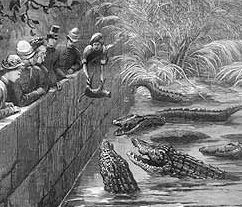



















































wow, Owais. Slave trade? I could never have guessed. This would be a wonderful future post. I would love to learn more about it.
All my life I have wondered how/why Makran coast had such interesting inhabitants. Now their history appears to be equally fascinating. There is so much more to their history and contribution to Karachi than just the special dances that we might remember from PTV, and their donkey cart races in the city!
karachi as slave trade market! WOW!
You do realize that now you will have to write a seperate post on that and tell us more about it ;-)
Adil
Sheedis now live in Southern districts of Karachi namely in and around Kharadar and Lyari area. There are atleast two historical notes which tell us about their origins. One is that Mohammad Bin Qasim’s army had employed them from Africa and brought to lower Sindh and Baluchistan. Atleast one person named ‘Shuja Habshi’ appears in notes that he fought with MBQ’s army in Sindh.
Second note of their arrival in Sindh comes from Alexander Bailie’s book which notes Karachi as a big slave trade market in late 1700s and early 1800s. This book was reprinted last year (2004-05) by the Dawn group of companies and I spent a fortune to buy a copy of it :) Alexander Bailie says that atleast 600 to 700 slaves were imported to Karachi every year. In one year (1837) at least 1500 African slaves were imported from Musqat, Oman and other african countries. Therefore it is highly probable that present day Sheedis are descendants from these African slaves brought to Karachi some 200 years ago.
Owais, these two posts have to be amongst the most interesting posts I have read in a long while. Thanks. I am intrigued by Sheedi Jaat which I had not known about. Do you have any more information on the Sheedis … for example, their numbers and also more on their origin and areas in which they now live… some of this is evident in the names of the tribes; but more information if you have it would be great.
Wow!! that was a very nice and well researched article. I lived in Karachi and had heard alot about Mango Pir and the crocodiles ther, but never got the chance to visit it.
Good reserach Owais. I sincerely hope you are planning to write a traveller’s guide to Pakistan!!